Temporal Downscaling of Crop Coefficients for Winter Wheat in the North China Plain: A Case Study at the Gucheng Agro-Meteorological Experimental Station
Abstract
:1. Introduction
2. Methodology and Materials
2.1. Gucheng Agro-Meteorological Experimental Station
2.2. Methodology
2.2.1. Reference Crop Evapotranspiration (ET0) Estimation
2.2.2. Estimation of Crop Evapotranspiration under Standard Conditions (ETc)
ETa Calculated Using Eddy Flux Measurements
ETa Calculated by Water Balance Equation
2.2.3. Crop Coefficient (Kc) Estimation
Proposed Stage-Wise Method
The FAO Method
2.2.4. Leave-One-Year-Out Cross-Validation
2.3. Materials
2.3.1. Meteorological Observations
2.3.2. Eddy Covariance Measurements
2.3.3. Soil Water Content Measurements
2.3.4. Remotely Sensed Leaf Area Index (LAI) Time Series
2.3.5. Meteorological Conditions during the Winter Wheat Growing Period
3. Results and Discussion
3.1. Energy Balance Closure of Flux Measurements
3.2. ET0 and ETa Dynamics
3.3. Estimated Kc at Three Different Temporal Scales
3.3.1. Comparison with the Four-Stage FAO Method
3.3.2. Kc Dynamics at the Critical Phenological Stages
3.3.3. Kc Dynamics at the Ten-Day Scale
3.4. LOOCV of the Estimated ETa Using the Proposed Stage-Wise Method
4. Conclusions
Acknowledgments
Author Contributions
Conflicts of Interest
References
- Allen, R.G.; Pereira, L.S.; Raes, D.; Smith, M. Crop Evapotranspiration: Guidelines for Computing Crop Water Requirements; FAO Irrigation & Drainage Paper 56; FAO: Rome, Italy, 1998. [Google Scholar]
- Farg, E.; Arafat, S.M.; Abd EI-Wahed, M.S.; EL-Gindy, A.M. Estimation of Evapotranspiration ETc and Crop Coefficient Kc of Wheat, in south Nile Delta of Egypt Using integrated FAO-56 approach and remote sensing data. Egypt. J. Remote Sens. Space Sci. 2012, 15, 83–89. [Google Scholar] [CrossRef]
- Kang, S.; Gu, B.; Du, T.; Zhang, J. Crop coefficient and ratio of transpiration to evapotranspiration of winter wheat and maize in a semi-humid region. Agric. Water Manag. 2003, 59, 239–254. [Google Scholar] [CrossRef]
- Ko, J.; Piccinni, G.; Marek, T.; Howell, T. Determination of growth-stage-specific crop coefficients (Kc) of cotton and wheat. Agric. Water Manag. 2009, 96, 1691–1697. [Google Scholar] [CrossRef]
- Abrisqueta, I.; Abrisqueta, J.M.; Tapia, L.M.; Munguía, J.P.; Conejero, W.; Vera, J.; Ruiz-Sánchez, M.C. Basal crop coefficients for early-season peach trees. Agric. Water Manag. 2013, 121, 158–163. [Google Scholar] [CrossRef]
- Marsal, J.; Johnson, S.; Casadesus, J.; Lopez, G.; Girona, J.; Stöckle, C. Fraction of canopy intercepted radiation relates differently with crop coefficient depending on the season and the fruit tree species. Agric. For. Meteorol. 2014, 184, 1–11. [Google Scholar] [CrossRef]
- Kumar, V.; Udeigwe, T.K.; Clawson, E.L.; Rohli, R.V.; Miller, D.K. Crop water use and stage-specific crop coefficients for irrigated cotton in the mid-south, United States. Agric. Water Manag. 2015, 156, 63–69. [Google Scholar] [CrossRef]
- Gao, Y.; Duan, A.; Sun, J.; Li, F.; Liu, Z.; Liu, H.; Liu, Z. Crop coefficient and water-use efficiency of winter wheat/spring maize strip intercropping. Field Crops Res. 2009, 111, 65–73. [Google Scholar] [CrossRef]
- Inmanbamber, N.G.; Mcglinchey, M.G. Crop coefficients and water-use estimates for sugarcane based on long-term Bowen ratio energy balance measurements. Field Crops Res. 2003, 83, 125–138. [Google Scholar] [CrossRef]
- Hanson, B.R.; May, D.M. Crop coefficients for drip-irrigated processing tomato. Agric. Water Manag. 2006, 81, 381–399. [Google Scholar] [CrossRef]
- Li, S.; Kang, S.; Li, F.; Zhang, L. Evapotranspiration and crop coefficient of spring maize with plastic mulch using eddy covariance in northwest China. Agric. Water Manag. 2008, 95, 1214–1222. [Google Scholar] [CrossRef]
- Zhou, L.; Zhou, G. Measurement and modelling of evapotranspiration over a reed (Phragmites australis) marsh in Northeast China. J. Hydrol. 2009, 372, 41–47. [Google Scholar] [CrossRef]
- Payero, J.O.; Irmak, S. Daily energy fluxes, evapotranspiration and crop coefficient of soybean. Agric. Water Manag. 2013, 129, 31–43. [Google Scholar] [CrossRef]
- Facchi, A.; Gharsallah, O.; Corbari, C.; Masseroni, D.; Mancini, M.; Gandolfi, C. Determination of maize crop coefficients in humid climate regime using the eddy covariance technique. Agric. Water Manag. 2013, 130, 131–141. [Google Scholar] [CrossRef]
- Liu, S.M.; Xu, Z.W.; Zhu, Z.L.; Jia, Z.Z.; Zhu, M.J. Measurements of evapotranspiration from eddy-covariance systems and large aperture scintillometers in the Hai River Basin, China. J. Hydrol. 2013, 487, 24–38. [Google Scholar]
- Jiang, X.; Kang, S.; Tong, L.; Li, F.; Li, D.; Ding, R.; Qiu, R. Crop coefficient and evapotranspiration of grain maize modified by planting density in an arid region of northwest China. Agric. Water Manag. 2014, 142, 135–143. [Google Scholar] [CrossRef]
- Zhang, H.; Anderson, R.G.; Wang, D. Satellite-based crop coefficient and regional water use estimates for Hawaiian sugarcane. Field Crops Res. 2015, 180, 143–154. [Google Scholar] [CrossRef]
- Bastiaanssen, W.G.M.; Menenti, M.; Feddes, R.A.; Holtslag, A.A.M. A remote sensing surface energy balance algorithm for land (SEBAL). 1. Formulation. J. Hydrol. 1998, 212–213, 198–212. [Google Scholar] [CrossRef]
- Norman, J.M.; Kustas, W.P.; Humes, K.S. A two-source approach for estimating soil and vegetation energy fluxes from observations of directional radiometric surface temperature. Agric. For. Meteorol. 1995, 77, 263–293. [Google Scholar] [CrossRef]
- Anderson, M.C.; Norman, J.M.; Mecikalski, J.R.; Otikin, J.A.; Kustas, W.P. A climatological study of evapotranspiration and moisture stress across the continental United States based on thermal remote sensing: 2. Surface moisture climatology. J. Geophys. Res. Atmos. 2007, 112, 311–368. [Google Scholar] [CrossRef]
- Sánchez, J.M.; López-Urrea, R.; Rubio, E.; González-Piqueras, J.; Vaselles, V. Assessing crop coefficients of sunflower and canola using two-source energy balance and thermal radiometry. Agric. Water Manag. 2014, 137, 23–29. [Google Scholar] [CrossRef]
- McMahon, T.A.; Peel, M.C.; Lowe, L.; Srikanthan, R.; McVicar, T.R. Estimating actual, potential, reference crop and pan evaporation using standard meteorological data: A pragmatic synthesis. Hydrol. Earth Syst. Sci. 2013, 17, 1331–1363. [Google Scholar] [CrossRef]
- McMahon, T.A.; Finlayson, B.L.; Peel, M.C. Historical developments of models for estimating evaporation using standard meteorological data. WIREs Water 2016, 3, 788–818. [Google Scholar] [CrossRef]
- Thornthwaite, C.W. An approach toward a rational classification of climate. Geogr. Rev. 1948, 38, 55–94. [Google Scholar] [CrossRef]
- Hargreaves, G.H.; Samani, Z.A. Reference crop evapotranspiration from temperature. Appl. Eng. Agric. 1985, 1, 96–99. [Google Scholar] [CrossRef]
- Priestley, C.H.B.; Taylor, R.J. On the assessment of surface heat and evaporation using large scale parameters. Mon. Weather Rev. 1972, 100, 81–92. [Google Scholar] [CrossRef]
- Tegos, A.; Malamos, N.; Koutsoyiannis, D. A parsimonious regional parametric evapotranspiration model based on a simplification of the Penman–Monteith formula. J. Hydrol. 2015, 524, 708–717. [Google Scholar] [CrossRef]
- Monteith, J.L. Evaporation and environment. In The State and Movement of Water in Living Organisms; Fogg, G.E., Ed.; Cambridge University Press: London, UK, 1965; Volume 19, pp. 205–234. [Google Scholar]
- Choudhury, B.U.; Singh, A.K.; Pradhan, S. Estimation of crop coefficients of dry-seeded irrigated rice–wheat rotation on raised beds by field water balance method in the Indo-Gangetic plains, India. Agric. Water Manag. 2013, 123, 20–31. [Google Scholar] [CrossRef]
- Su, M.; Li, J.; Rao, M. Estimation of crop coefficients for sprinkler-irrigated winter wheat and sweet corn using a weighing lysimeter. Trans. Chin. Soc. Agric. Eng. 2005, 21, 25–29. [Google Scholar]
- Liu, H.; Kang, Y. Calculation of crop coefficient of winter wheat at elongation-heading stages. Trans. Chin. Soc. Agric. Eng. 2006, 22, 52–56. [Google Scholar]
- Li, H.L.; Luo, Y.; Zhao, C.J.; Yang, G.J. Estimating crop coefficients of winter wheat based on canopy spectral vegetation indices. Trans. Chin. Soc. Agric. Eng. 2013, 29, 118–127. [Google Scholar]
- Zhang, H.; Feng, L.P. Characteristics of Spatio-temporal Variation of Precipitation in North China in Recent 50 Years. J. Nat. Resour. 2010, 25, 270–279. [Google Scholar]
- Mao, F.; Zhao, Y.J.; Sun, H.; Shao, P.; Liao, S.H.; Jiang, H.F.; Zheng, X.B. Spatial and Temporal Change Characteristics of ÅngstrÖm-Prescott Coefficients in China in 1961–2010. Meteorol. Environ. Sci. 2016, 39, 43–51. [Google Scholar]
- Silva, V.P.R.; Silva, B.B.; Albuquerque, W.G.; Borges, C.J.R.; Sousa, I.F.; Neto, J.D. Crop coefficient, water requirements, yield and water use efficiency of sugarcane growth in Brazil. Agric. Water Manag. 2013, 128, 102–109. [Google Scholar] [CrossRef]
- Wang, Z.; Wu, P.; Zhao, X.; Gao, Y.; Chen, X. Water use and crop coefficient of the wheat-maize strip intercropping system for an arid region in northwestern China. Agric. Water Manag. 2015, 161, 77–85. [Google Scholar] [CrossRef]
- Yilmaz, M.T.; Hunt, E.R.; Jackson, T.J. Remote sensing of vegetation water content from equivalent water thickness using satellite imagery. Remote Sens. Environ. 2008, 112, 2514–2522. [Google Scholar] [CrossRef]
- Maatouk, H.; Roustant, O.; Richet, Y. Cross-Validation Estimations of Hyper-Parameters of Gaussian Processes with Inequality Constraints. Procedia Environ. Sci. 2015, 27, 38–44. [Google Scholar] [CrossRef]
- Zhang, T. A leave-one-out cross validation bound for kernel methods with applications in learning. In Computational Learning Theory: Lecture Notes in Computer Science; Springer: Berlin/Heidelberg, Germany, 2001; pp. 427–443. [Google Scholar]
- Guo, J.X. Characters and Parameterization Comparisons of Turbulent Transfer over Maize Field on North China Plain. Ph.D. Dissertation, Chinese Academy of Meteorological Sciences and Nanjing University of Information Science & Technology, Nanjing, China, 2006. [Google Scholar]
- Berger, B.W.; Davis, K.J.; Yi, C.; Bakwin, P.S.; Zhao, C.L. Long-Term Carbon Dioxide Fluxes from a Very Tall Tower in a Northern Forest: Flux Measurement Methodology. J. Atmos. Ocean. Technol. 2001, 18, 529–542. [Google Scholar] [CrossRef]
- Zhang, P.; Yuan, G.F.; Zhu, Z.L. Determination of the average period of Eddy covariance measurement and its influences on the calculation of fluxes in desert riparian forest. Arid Land Geogr. 2013, 36, 400–408. [Google Scholar]
- Liu, Y.J.; Hu, F.; Cheng, X.L.; Feng, Y.F. Data processing and quality assessment of the eddy covariance system of the 325-meter meteorology tower in Beijing. Chin. J. Atmos. Sci. 2016, 40, 390–400. (In Chinese) [Google Scholar]
- Zhu, Z.L.; Sun, X.M.; Wen, X.F.; Zhou, Y.L.; Tian, J.; Yuan, G.F. Study on the processing method of nighttime CO2 eddy covariance flux data in China FLUX. Sci. China Earth Sci. 2006, 49, 36–46. [Google Scholar] [CrossRef]
- Falge, E.; Baldocchi, D.; Olson, R.; Anthoni, P.; Aubinet, M.; Bernhofer, C.; Burba, G.; Ceulemans, R.; Clement, R.; Dolman, H.; et al. Gap filling strategies for defensible annual sums of net ecosystem exchange. Agric. For. Meteorol. 2001, 107, 43–69. [Google Scholar] [CrossRef]
- Zhou, L.; Zhou, G.; Liu, S.; Sui, X. Seasonal contribution and interannual variation of evapotranspiration over a reed marsh (Phragmites australis) in Northeast China from 3-year eddy covariance data (pages 1039–1047). Hydrol. Process. 2010, 24, 1039–1047. [Google Scholar] [CrossRef]
- Gu, J.; Smith, E.A.; Merritt, J.D. Testing energy balance closure with GOES-retrieved net radiation and in situ measured eddy correlation fluxes in BOREAS. J. Geophys. Res. Atmos. 1999, 104, 27881–27894. [Google Scholar] [CrossRef]
- Wilson, K.; Goldstein, A.; Falge, E.; Aubinet, M.; Baldocchi, D.; Berbigier, P.; Bernhofer, C.; Ceulemans, R.; Dolman, H.; Field, C.; et al. Energy balance closure at FLUXNET sites. Agric. For. Meteorol. 2002, 113, 223–243. [Google Scholar] [CrossRef]
- Liu, R.H.; Zhu, Z.X.; Fang, W.S.; Deng, T.H.; Zhao, G.Q. Distribution pattern of winter wheat root system. Chin. J. Ecol. 2008. [Google Scholar] [CrossRef]
- Liu, Y.; Teixeira, J.L.; Zhang, H.J.; Pereira, L.S. Model validation and crop coefficients for irrigation scheduling in the North China plain. Agric. Water Manag. 1998, 36, 233–246. [Google Scholar] [CrossRef]
- Parkes, M.; Wang, J.; Knowles, R. Peak crop coefficient values for Shaanxi, North-west China. Agric. Water Manag. 2005, 73, 149–168. [Google Scholar] [CrossRef]

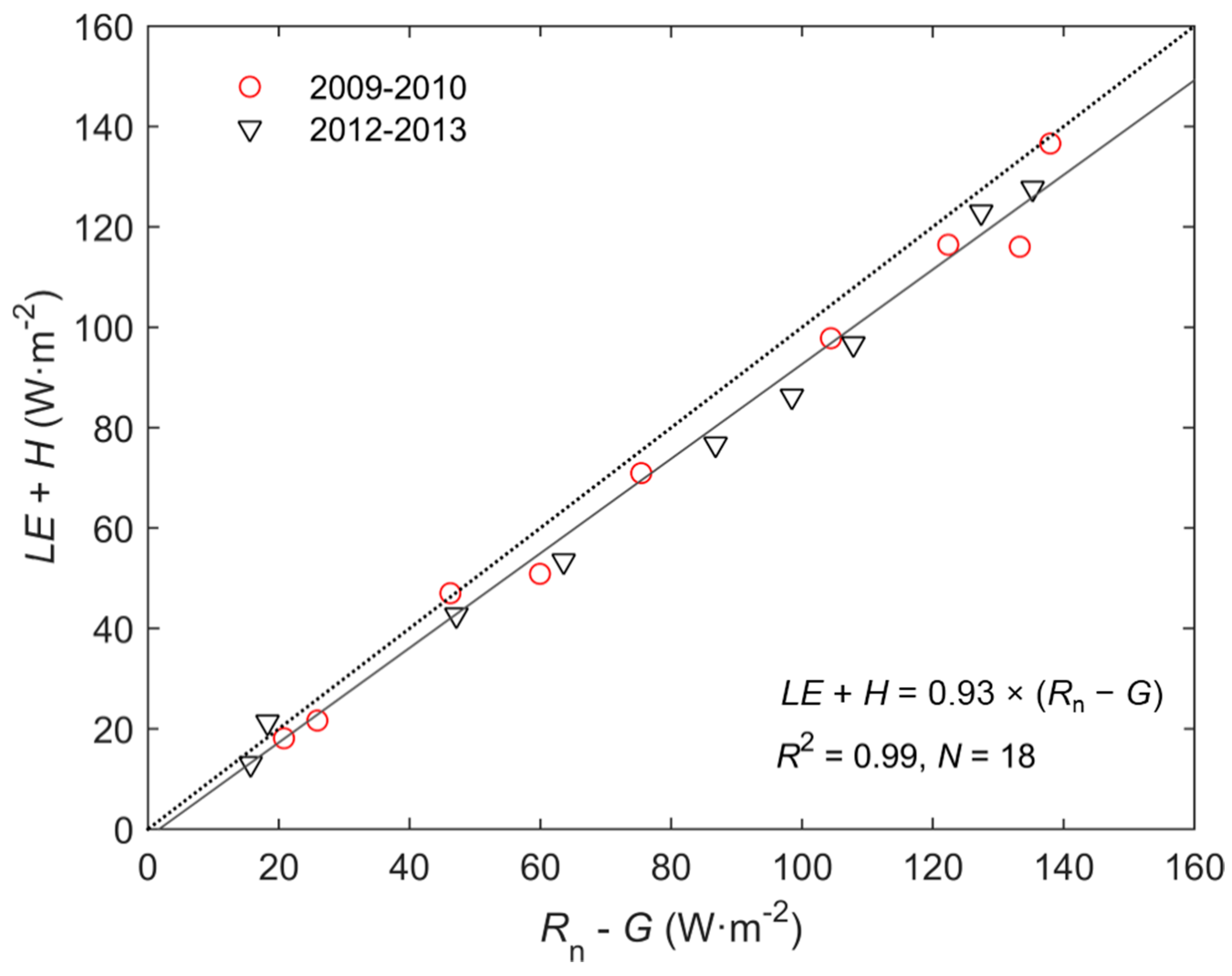
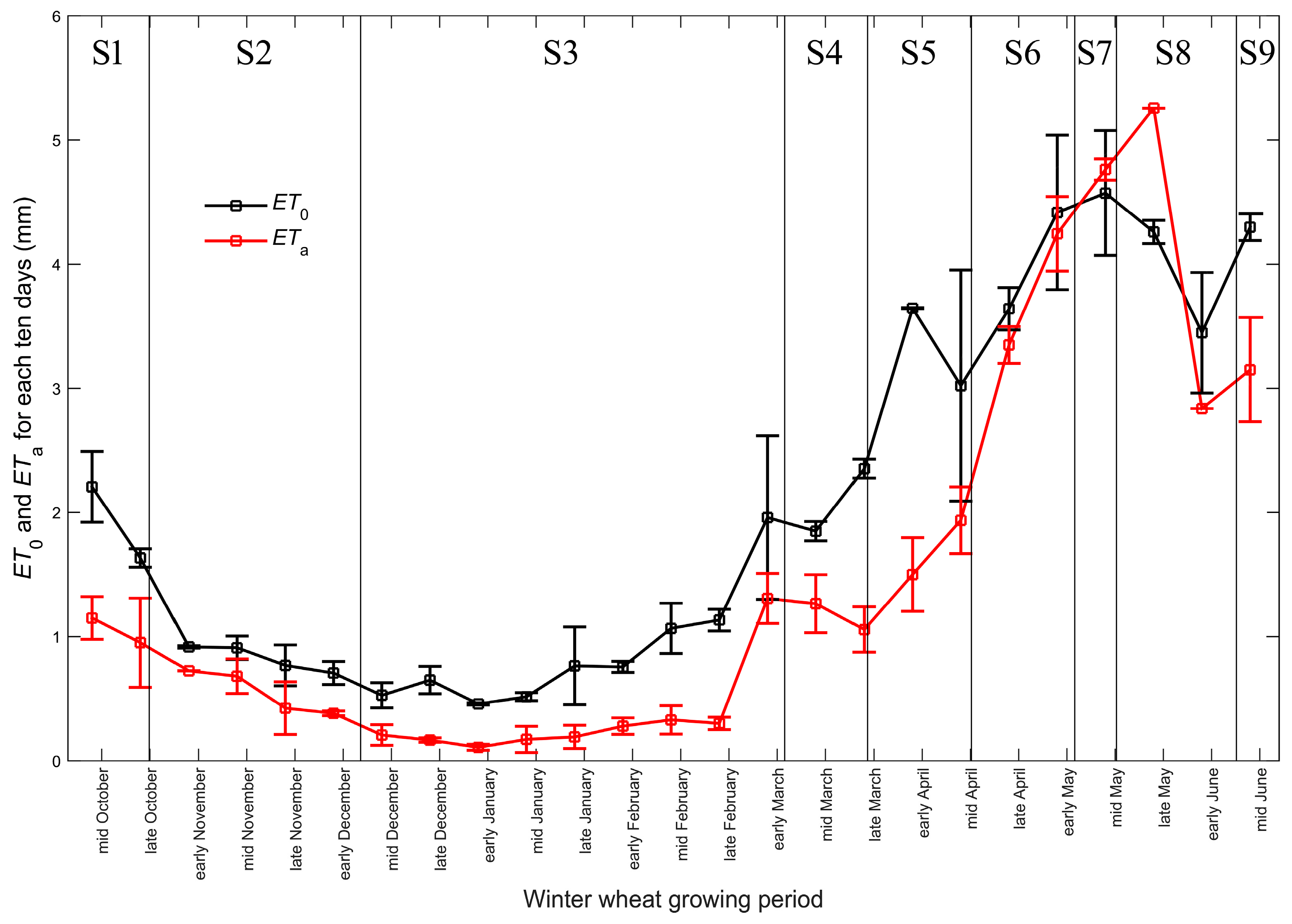
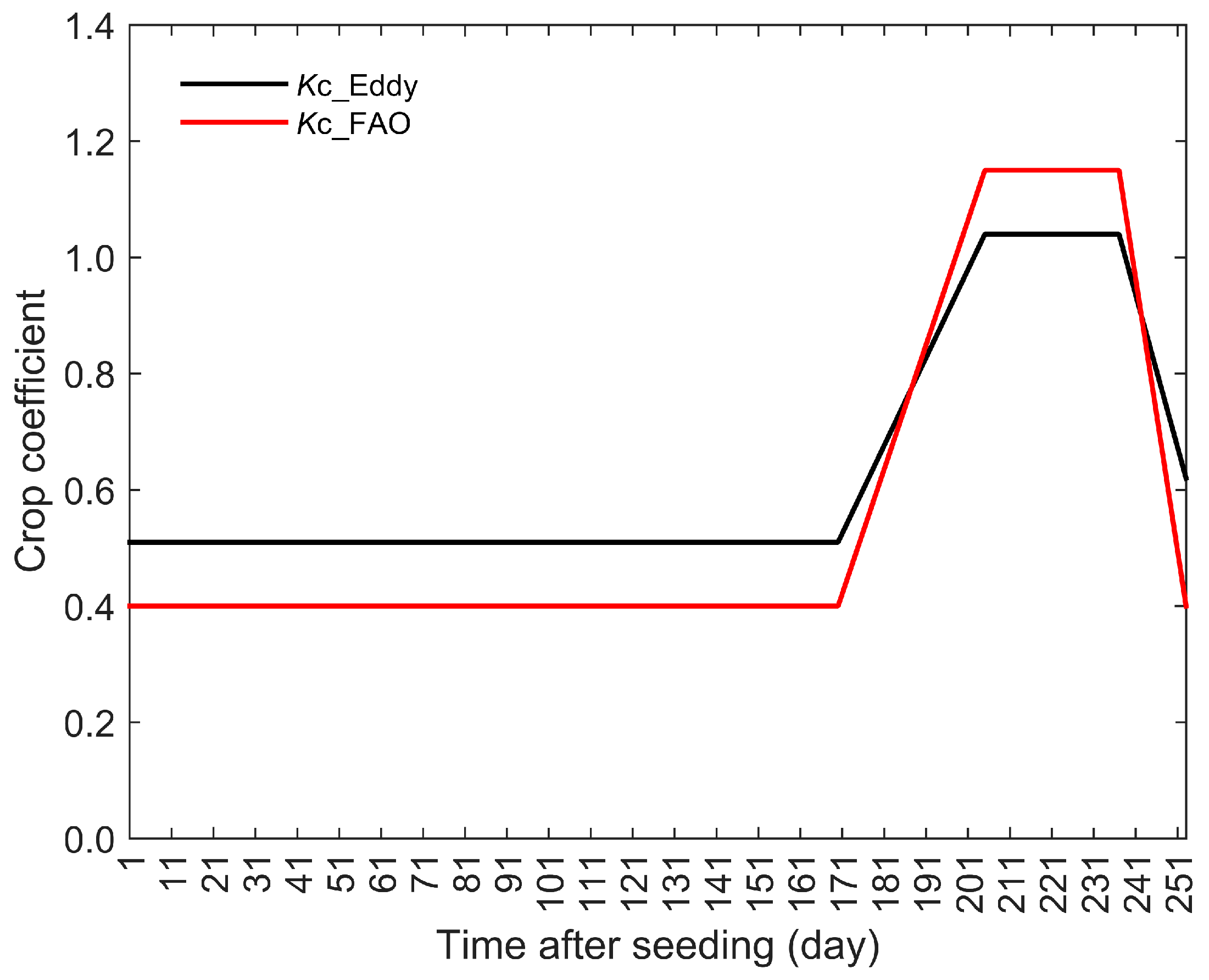
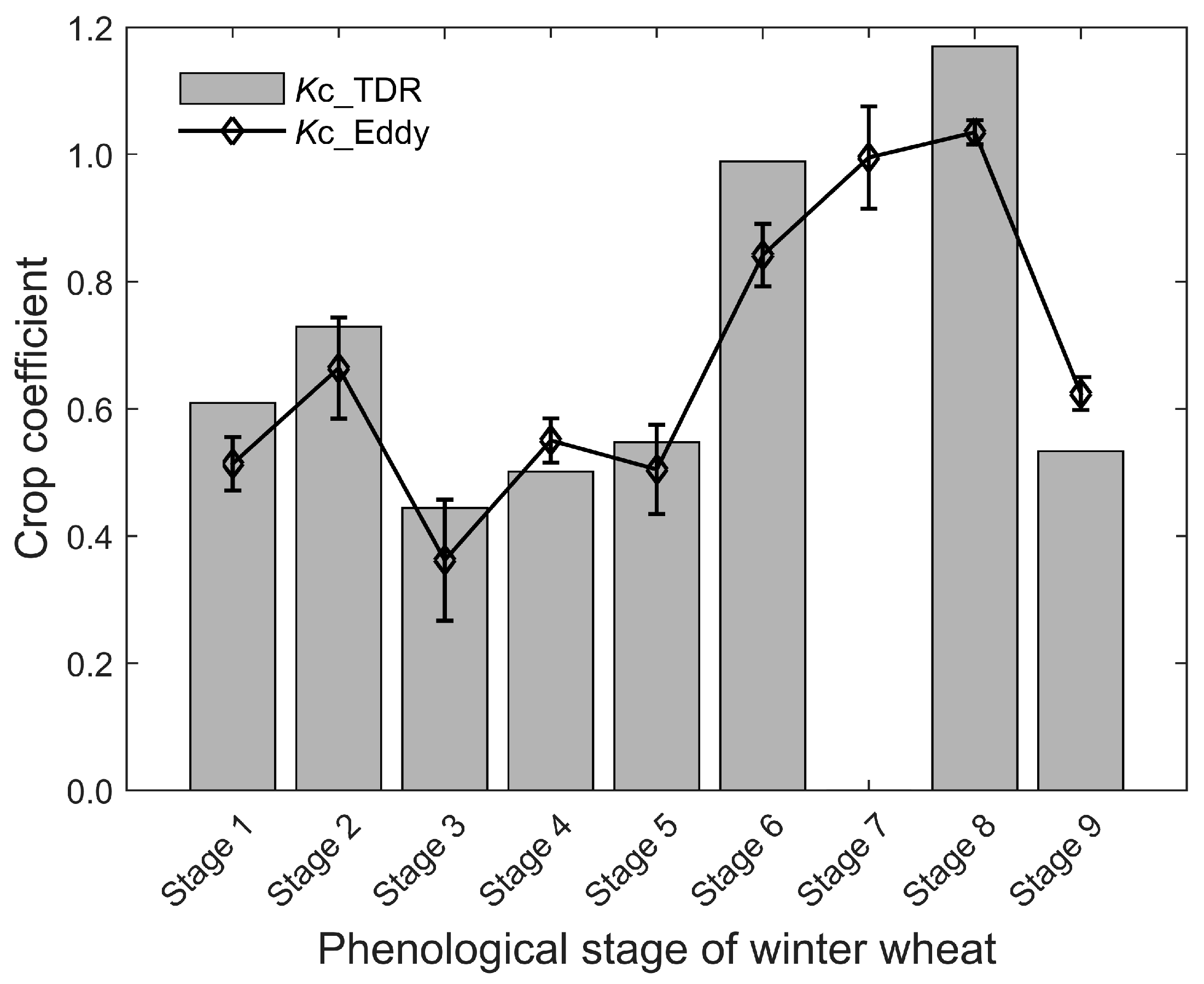
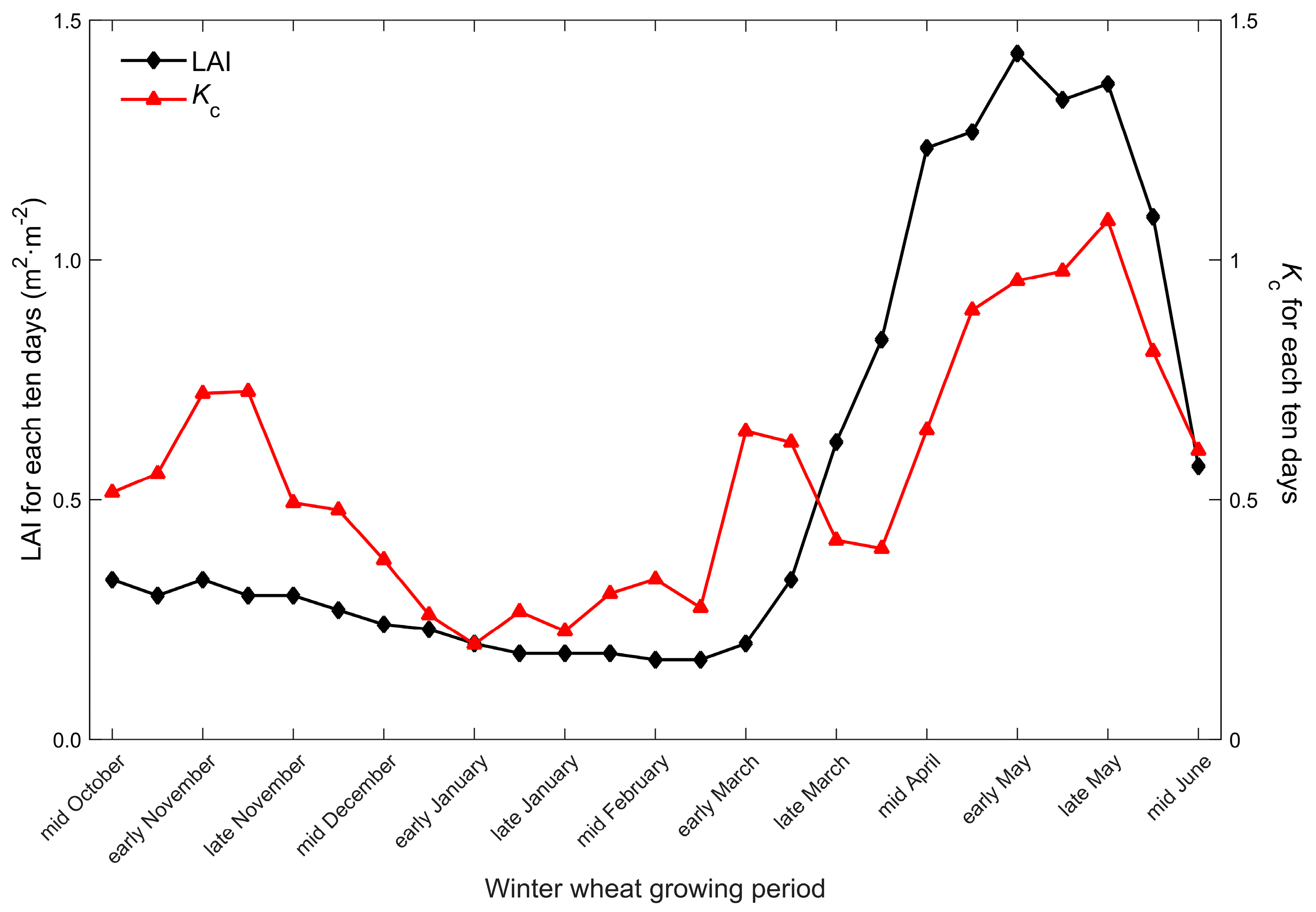
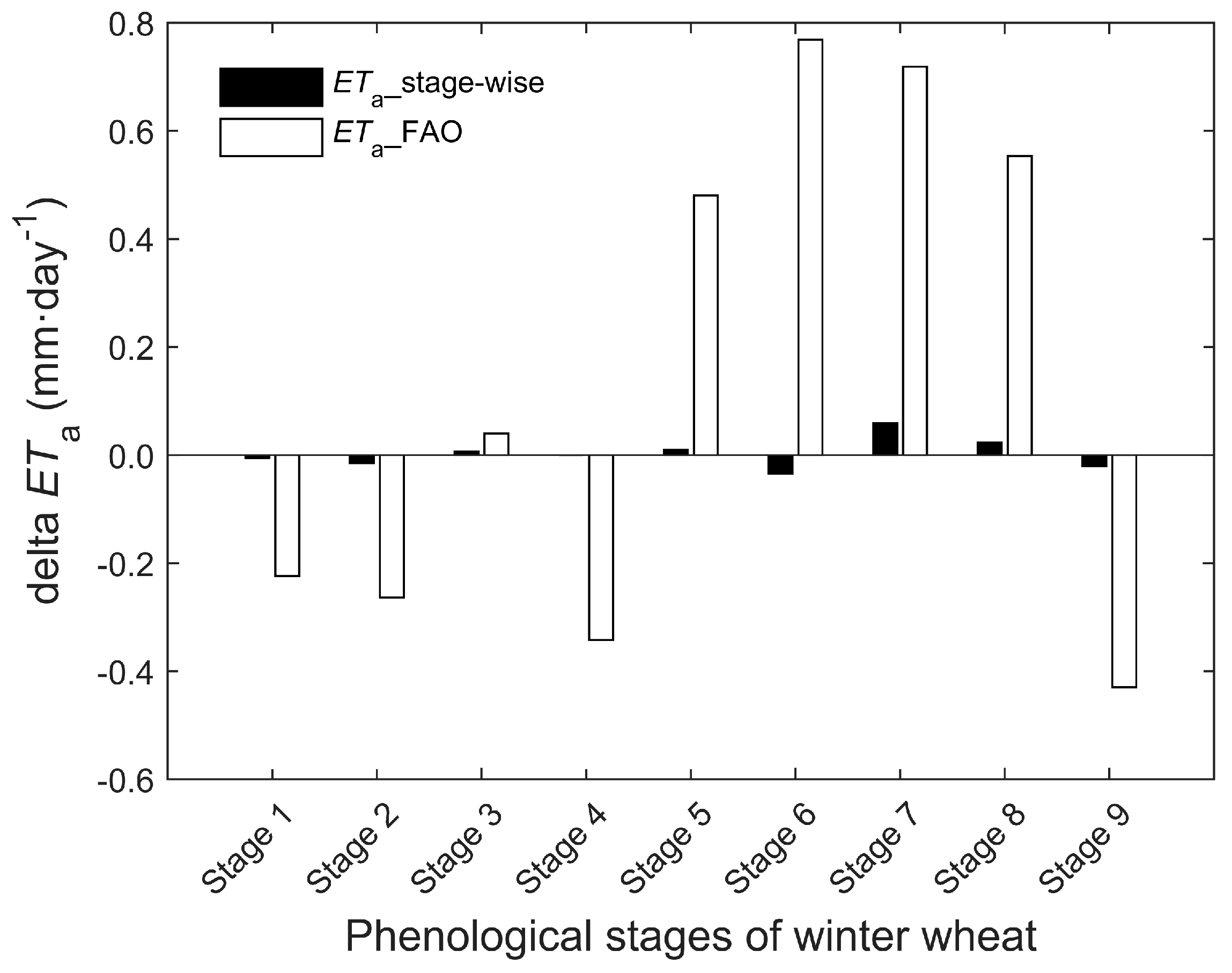
| Year | Variety | Seeding Date MM/DD | Ripening Date MM/DD | Average Temperature (°C) | Average Maximum Temperature (°C) | Average Minimum Temperature (°C) |
|---|---|---|---|---|---|---|
| 2009–2010 | Jimai-22 | 10/10 | 6/20 | 5.9 | 11.7 | 0.6 |
| 2012–2013 | Jimai-22 | 10/08 | 6/19 | 5.8 | 12.4 | 0.4 |
| DOY | Phenological Stages | Stage-Wise Method | FAO Method |
|---|---|---|---|
| DOY284 | Seeding | Stage 1 | Initial stage |
| DOY290 | Seedling emergence | ||
| DOY304 | Three-leaf | Stage 2 | |
| DOY321 | Tiller | ||
| DOY338 | Stop growing | Stage 3 | |
| DOY062 | Green-up | Stage 4 | |
| DOY088 | Erect-growing | Stage 5 | Development stage |
| DOY111 | Elongation | Stage 6 | |
| DOY122 | Booting | Stage 7 | Mid-season stage |
| DOY130 | Heading | Stage 8 | |
| DOY136 | Blossom | ||
| DOY155 | Milk | Stage 9 | Late-season stage |
| DOY171 | Ripening |
| Growing Period | Stage-Wise Method | FAO Method | ||||
|---|---|---|---|---|---|---|
| k * | R2 | RMSE (mm·Day−1) | k * | R2 | RMSE (mm·Day−1) | |
| 2009–2010 | 0.95 | 0.86 | 0.10 | 1.05 | 0.88 | 0.09 |
| 2012–2013 | 0.98 | 0.91 | 0.05 | 1.09 | 0.91 | 0.21 |
| Sum-up | 0.97 | 0.89 | 0.07 | 1.08 | 0.90 | 0.16 |
| Growing Period | Stage-Wise Method | FAO Method | ||||
|---|---|---|---|---|---|---|
| k * | R2 | RMSE (mm·Day−1) | k * | R2 | RMSE (mm·Day−1) | |
| 2009–2010 | 0.99 | 0.96 | 0.03 | 1.07 | 0.92 | 0.20 |
| 2012–2013 | 1.00 | 0.95 | 0.01 | 1.13 | 0.96 | 0.34 |
| Sum-up | 1.00 | 0.96 | 0.01 | 1.09 | 0.93 | 0.27 |
© 2017 by the authors. Licensee MDPI, Basel, Switzerland. This article is an open access article distributed under the terms and conditions of the Creative Commons Attribution (CC BY) license ( http://creativecommons.org/licenses/by/4.0/).
Share and Cite
Wang, P.; Qiu, J.; Huo, Z.; Anderson, M.C.; Zhou, Y.; Bai, Y.; Liu, T.; Ren, S.; Feng, R.; Chen, P. Temporal Downscaling of Crop Coefficients for Winter Wheat in the North China Plain: A Case Study at the Gucheng Agro-Meteorological Experimental Station. Water 2017, 9, 155. https://doi.org/10.3390/w9030155
Wang P, Qiu J, Huo Z, Anderson MC, Zhou Y, Bai Y, Liu T, Ren S, Feng R, Chen P. Temporal Downscaling of Crop Coefficients for Winter Wheat in the North China Plain: A Case Study at the Gucheng Agro-Meteorological Experimental Station. Water. 2017; 9(3):155. https://doi.org/10.3390/w9030155
Chicago/Turabian StyleWang, Peijuan, Jianxiu Qiu, Zhiguo Huo, Martha C. Anderson, Yuyu Zhou, Yueming Bai, Tao Liu, Sanxue Ren, Rui Feng, and Pengshi Chen. 2017. "Temporal Downscaling of Crop Coefficients for Winter Wheat in the North China Plain: A Case Study at the Gucheng Agro-Meteorological Experimental Station" Water 9, no. 3: 155. https://doi.org/10.3390/w9030155






